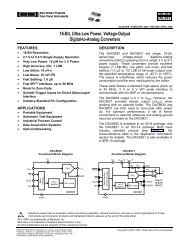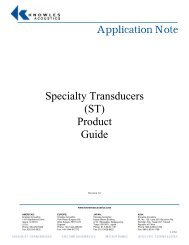DAC8532: Dual-Channel, Low-Power, 16-Bit, Serial-Input ... - dreamm
DAC8532: Dual-Channel, Low-Power, 16-Bit, Serial-Input ... - dreamm
DAC8532: Dual-Channel, Low-Power, 16-Bit, Serial-Input ... - dreamm
You also want an ePaper? Increase the reach of your titles
YUMPU automatically turns print PDFs into web optimized ePapers that Google loves.
+5V<br />
R 2<br />
10kΩ<br />
R 1<br />
10kΩ<br />
+5V<br />
V OUT X<br />
OPA703<br />
±5V<br />
V DD , V REF<br />
<strong>DAC8532</strong><br />
10µF 0.1µF –5V<br />
(Other pins omitted for clarity.)<br />
FIGURE 11. Bipolar Operation with the <strong>DAC8532</strong>.<br />
The output voltage for any input code can be calculated as<br />
follows:<br />
⎡ D R R<br />
R<br />
VOUTX = VREF • ⎛ VREF<br />
⎝ ⎜ ⎞ ⎛ + ⎞<br />
⎟ •<br />
⎠ ⎜<br />
⎝ R<br />
⎟ • ⎛<br />
⎠ ⎝ ⎜ ⎞ ⎤<br />
1 2<br />
2<br />
⎢<br />
–<br />
R<br />
⎟ ⎥<br />
⎣⎢<br />
65536 1<br />
1 ⎠ ⎦⎥<br />
where D represents the input code in decimal (0–65535).<br />
With V REF = 5V, R 1 = R 2 = 10kΩ:<br />
⎛ 10 • D ⎞<br />
VOUT X = ⎜ ⎟ – 5V<br />
⎝ 65536⎠<br />
This is an output voltage range of ±5V with 0000 H corresponding<br />
to a –5V output and FFFF H corresponding to a +5V<br />
output. Similarly, using V REF = 2.5V, a ±2.5V output voltage<br />
range can be achieved.<br />
LAYOUT<br />
A precision analog component requires careful layout, adequate<br />
bypassing, and clean, well-regulated power supplies.<br />
The <strong>DAC8532</strong> offers single-supply operation, and it will often<br />
be used in close proximity with digital logic, microcontrollers,<br />
microprocessors, and digital signal processors. The more<br />
digital logic present in the design and the higher the switching<br />
speed, the more difficult it will be to keep digital noise<br />
from appearing at the output.<br />
Due to the single ground pin of the <strong>DAC8532</strong>, all return<br />
currents, including digital and analog return currents for the<br />
DAC, must flow through a single point. Ideally, GND would<br />
be connected directly to an analog ground plane. This plane<br />
would be separate from the ground connection for the digital<br />
components until they were connected at the power entry<br />
point of the system.<br />
The power applied to V DD should be well regulated and low<br />
noise. Switching power supplies and DC/DC converters will<br />
often have high-frequency glitches or spikes riding on the<br />
output voltage. In addition, digital components can create<br />
similar high-frequency spikes as their internal logic switches<br />
states. This noise can easily couple into the DAC output<br />
voltage through various paths between the power connections<br />
and analog output.<br />
As with the GND connection, V DD should be connected to a<br />
positive power-supply plane or trace that is separate from the<br />
connection for digital logic until they are connected at the<br />
power entry point. In addition, a 1µF to 10µF capacitor in<br />
parallel with a 0.1µF bypass capacitor is strongly recommended.<br />
In some situations, additional bypassing may be<br />
required, such as a 100µF electrolytic capacitor or even a<br />
“Pi” filter made up of inductors and capacitors—all designed<br />
to essentially low-pass filter the supply, removing the highfrequency<br />
noise.<br />
<strong>16</strong><br />
www.ti.com<br />
<strong>DAC8532</strong><br />
SBAS246A















